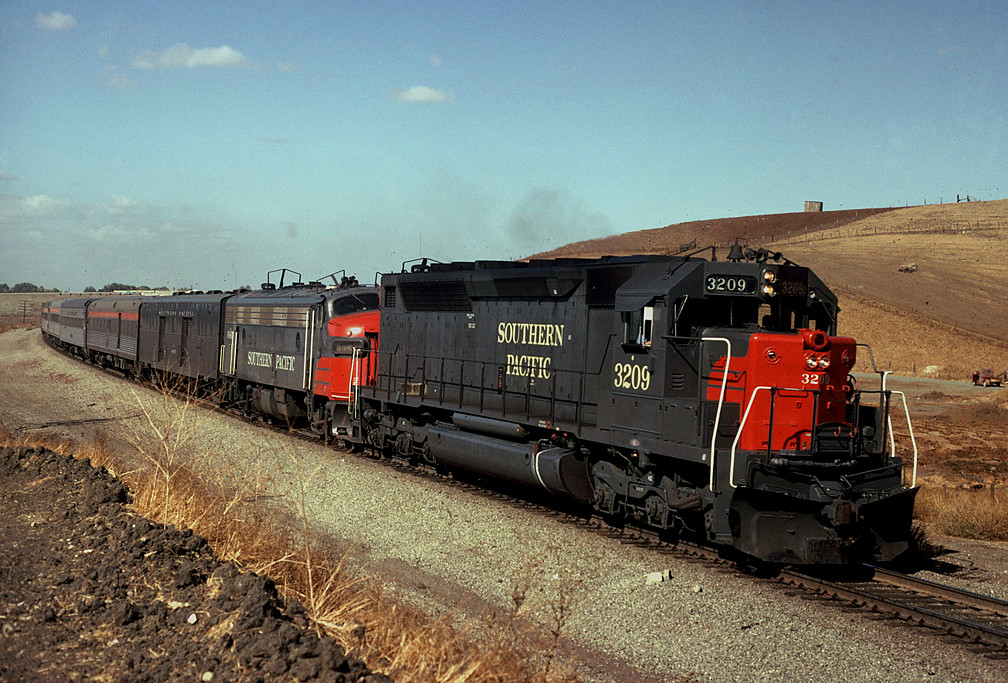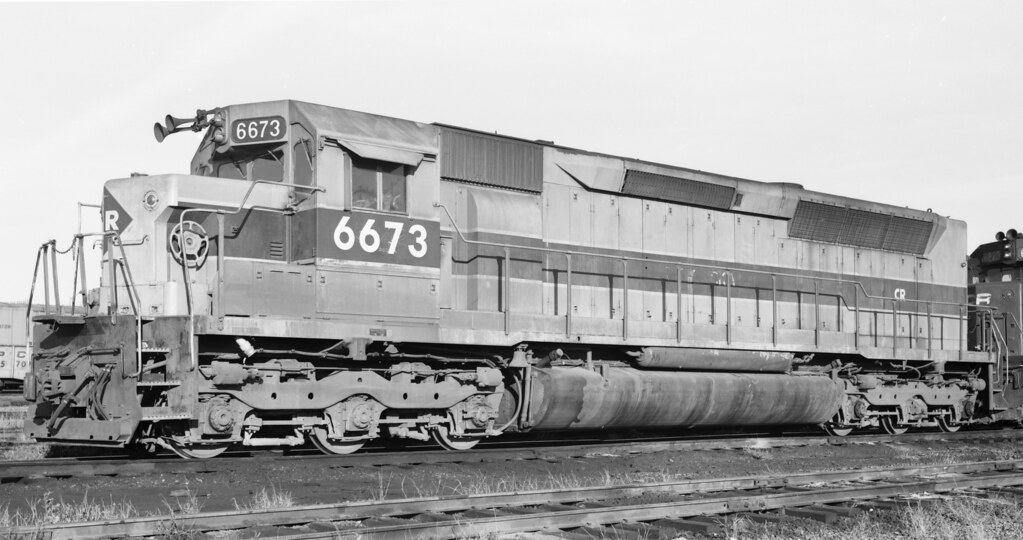#sdp45
Text

Orders on the Hoop
A westbound Conrail freight train is approaching Effingham, Illinois. The train is due to receive orders by way of paper “flimsies,” two of which can be seen in the order hoop.
This line was formerly Penn Central and Pennsylvania Railroad prior to that, as the distinctive signal indicates. The locomotive on point is a unique variation of the SDP45 built for the Erie Lackawanna, which was folded into Conrail on April 1st 1976.
One image by Richard Koenig; taken in February of 1979.
#railroadhistory#railwayhistory#conrail#penncentral#pennsy#effinghamillinois#effinghamil#effingham#sdp45
38 notes
·
View notes
Video
SP 3209 South of Curtner Feb 71xRP por Drew Jacksich
Por Flickr:
Train #98 the Eatbound Coast Daylight after passing under Curtner Ave. in South San Jose, Feb 1971
10 notes
·
View notes
Video
Soon to be Stablemates by Kevin Cavanaugh
Via Flickr:
It's March 4, 1986 and a SP eastbound "hauler" led by SDP45 3206 meets a westbound manifest with DRGW SD40T-2 5391 in charge, in the siding at Pomona, CA. The SPSF merger has yet to be denied by the ICC, and both SP and SF are painting locomotives into the "kodachrome" SPSF paint scheme. In four short months, the SPSF merger will be history. Two years later SP would become part of Rio Grande Industries, and scenes like this will become commonplace. But when photographed, the Rio Grande is just another pool or run-through partner with SP. The Rio Grande power in SoCal is probably just equalizing hours/mileage.
20 notes
·
View notes
Photo
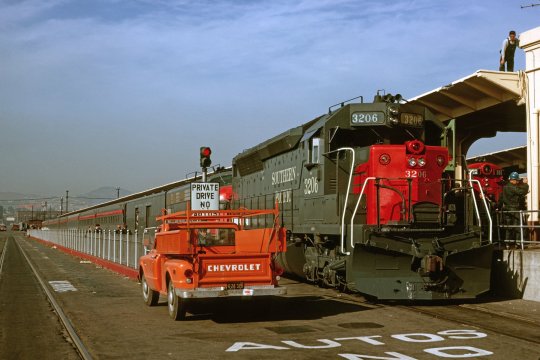
Southern Pacific's final overnight "Lark" arrives at San Francisco's 3rd & Townsend Depot, led by SDP45 #3206 and an FP7, on April 7, 1968. Drew Jacksich photo.
#lark#sp#southern pacific#1968#los angeles#san francisco#trains#passenger train#history#3rd & townsend depot#california
64 notes
·
View notes
Photo

Day 23: EMD SDP40F
Info from Wikipedia:
The EMD SDP40F was a six-axle 3,000 hp (2.2 MW) C-C diesel–electric locomotive built by General Motors Electro-Motive Division (EMD) from 1973–1974. EMD built 150 for Amtrak, the operator of most intercity passenger trains in the United States. Amtrak, a private company but funded by the United States government, had begun operation in 1971 with a fleet of aging diesel locomotives inherited from various private railroads. The SDP40F was the first diesel locomotive built new for Amtrak and for a brief time they formed the backbone of the company's long-distance fleet.
A series of derailments in the mid-1970s shattered Amtrak's confidence in the locomotive, and many railroads banned it from their tracks. Multiple investigations pointed to issues with the locomotive's trucks, the weight of the water and steam generators used for train heating, or the harmonic vibration of baggage cars behind the locomotive. In 1977 Amtrak decided to move on from the SDP40F in favor of the EMD F40PH, which was already in use on short-distance routes. Amtrak traded most of its fleet into EMD; the components were incorporated into new F40PHs. The remainder were traded to the Atchison, Topeka and Santa Fe Railway (ATSF) for use in freight service. The Santa Fe rebuilt the locomotives and designated them SDF40-2. The Burlington Northern Santa Fe Railway (BNSF), successor to the Santa Fe, retired them in 2002. One of them is preserved.
Amtrak assumed operation of most intercity rail passenger service in the United States on May 1, 1971. Until then such services were operated by various private railroads. The private railroads chose to retain their second generation passenger locomotives for freight service, or to operate the various commuter services which, by law, did not pass to Amtrak. To operate these intercity services the Amtrak had to buy or lease from the private railroads whatever locomotives remained. This left Amtrak with an aging and mechanically-incompatible fleet of diesel locomotives. The mainstays of Amtrak's road diesel fleet were veteran E units and F units, which were 10–20 years old and due for replacement.
The SDP40F was a full-width cowl unit. It was based on the EMD FP45 passenger locomotive and EMD SD40-2 freight locomotive. All three shared the EMD 645E3 diesel prime mover, which developed 3,000 hp (2.2 MW). The locomotive had a gear ratio of 57:20. Maximum speed at full horsepower was 94 mph (151.3 km/h); the locomotive exceeded 100 miles per hour (160.9 km/h) in tests. There were doubts at the time about Amtrak's long-term viability, so the locomotives were designed for easy conversion to freight locomotives should Amtrak cease operation.
In the early 1970s Amtrak's passenger car fleet was steam-heated; Amtrak's requirement called for two steam generators. These were located at the rear of the locomotive. Forward of the generators was a 1,350-US-gallon (5,110.3 l; 1,124.1 imp gal) water tank. This tank rested above the floorline. The lateral motion of the water within was later implicated in several derailments. The primary underbody tank was split between water and diesel fuel, carrying 2,150 US gallons (8,138.6 l; 1,790.2 imp gal) of water and 2,500 US gallons (9,463.5 l; 2,081.7 imp gal) of diesel. Provision was made for eventual conversion to head-end power (HEP), but it was never carried out.
EMD based the SDP40F name on the existing SDP40. Several years earlier, EMD had made similar versions of the SDP45 and SD45 in a full-width cowl unit, which it named FP45 and F45. Although the SDP40F was externally nearly identical to the FP45, EMD chose not to give the new locomotive a similar name such as FP40. EMD wanted to avoid adding a new locomotive type to their catalog due to price controls in effect in the early 1970s. The following year, the F40C name was used for a similar locomotive ordered by the Chicago, Milwaukee, St. Paul and Pacific Railroad (the "Milwaukee Road"), equipped with HEP instead of steam generators.
There were several minor differences between the first 40 locomotives built and later examples. The most important was the installation of lower-profile cooling fans and air horns to avoid clearance problems in the Eastern US.
Amtrak ordered 150 SDP40Fs, in two batches. The first order, placed on November 2, 1972, was for 40 locomotives, at a cost of $18 million. A second order, for 110 locomotives at $50 million, followed on October 12, 1973. These orders were Amtrak's first for new-build locomotives.[18] Amtrak deployed the original 40 locomotives on long-distance trains in the Western United States. The locomotives entered revenue service on June 22, 1973, hauling the Super Chief from Chicago to Los Angeles over the Atchison, Topeka and Santa Fe Railway. SDP40Fs were also used on the Burlington Northern Railroad. The arrival of the second order enabled Amtrak to deploy the SDP40Fs throughout the country, displacing the inherited E-units.
In late 1975 J. David Ingles called the SDP40Fs the "stars of Amtrak's long-distance trains," but engine crews reported that the locomotives rode poorly compared to the E-units they had replaced. Even as Amtrak and EMD investigated the ride quality, the SDP40F was involved in a series of derailments that would lead to an end to its career as a passenger locomotive. Between 1974–1976 the Federal Railroad Administration (FRA) identified thirteen incidents for which the locomotive was responsible. None of the incidents were serious, but their frequency was a concern. Most of the derailments occurred on trains with two SDP40Fs on the front and at least one trailing baggage car. While the rear truck of the second locomotive and the front truck of the baggage car were pinpointed as the source of the derailment, the actual cause of the derailments was unclear.
EMD, Amtrak, the Association of American Railroads (AAR), and the FRA tested the locomotive thoroughly, with suspicion falling on the "hollow bolster" truck design. In the end, the investigators theorized that the steam generators and water tank may have made the rear of the engine too heavy and created too much lateral motion. Later FRA investigations concluded that the actual culprit was the light weight of the baggage cars, which caused harmonic vibrations when placed directly behind the much heavier SDP40F. A contributing factor was the sometimes poor quality of track the locomotive operated over.
Amtrak took several corrective measures, including operating with a reduced speed on curves, emptying the smaller of the two water tanks to reduce lateral motion, and making various alterations to the trucks. The measures helped, but the trouble continued. Several railroads, including the Burlington and the Chesapeake and Ohio Railway (C&O), banned the "rail breakers" from their tracks (they were suspected or known to be causing the spreading of rails because of their lateral swaying, which may have contributed to the derailments)[citation needed]. For the Chicago–Seattle Empire Builder, the speed restrictions added 6 hours to what had been a 46-hour schedule. Another important development was the unusually harsh winter of 1976–1977, which sidelined many of Amtrak's aging steam-heated coaches. Amtrak suspended numerous routes and pressed the new HEP-equipped Amfleet I coaches, designed for short runs, into service. The new EMD F40PH, intended for short-distance service and equipped with HEP, handled these trains.
In the spring of 1977 Amtrak faced a power crisis. In addition to the SDP40Fs derailing, Amtrak was having trouble with two other six-axle designs. The GE E60CP and E60CH electric locomotives were having derailment problems. The GE P30CH had the same truck design as E60s and rode poorly, although it did not exhibit the same tendency to derail. Amtrak decided to abandon the SDP40F in favor of the F40PH, a four-axle design with none of the riding problems of the six-axle locomotives. Amtrak traded 40 SDP40Fs back to EMD. Components including the prime mover were installed into an F40PH's frame. Between 1977–1987 Amtrak traded 132 of the SDP40Fs back to EMD for F40PHRs. The SDP40F remained in service on the Santa Fe longer than elsewhere, although the arrival of HEP-equipped Superliner cars on the Western routes displaced them from there as well. The last SDP40Fs left the Amtrak roster in 1987. The remaining Amtrak SDP40F's that weren't sold to the ATSF (seen below) are presumed to have been scrapped.
In 1984 Amtrak, low on light-duty power, traded 18 SDP40Fs to the Santa Fe for 43 switchers: 25 CF7s and 18 SSB1200s. Santa Fe rebuilt the traded locomotives for freight use. Modifications included removing the steam generators and regearing for lower speed. The locomotives were also given front steps and platforms, and notched noses in order to improve boarding access. The rebuilt locomotives were designated SDF40-2. The SDF40-2s continued in service with the BNSF Railway, successor to the Santa Fe, until their retirement in 2002.
One SDF40-2, ex-Amtrak No. 644, was acquired by Dynamic Rail Preservation Inc. and is in Boulder City, Nevada having been previously displayed in Ogden, Utah. It has been renumbered to its Santa Fe-era 6976 number and returned to operation in November 2019.
models and route by: American Trainz Group, trainzman54, Auran, and Download Station
#EMD#EMD SDP40F#Amtrak SDP40F#SDP40F#Amtrak#Diesel Locomotive#Trainz Simulator#Trains#Advent Calendar#Christmas#Christmas 2022 🎄🎅🎁
2 notes
·
View notes
Video
Southern Pacific SDP45s 3207 and 3201 eastbound Super Bowl Train to New Orleans at Sargent, CA on the Coast Line on January 20, 1986 -- 2 Photos by Marty Bernard
Via Flickr:
A Roger Puta Photograph
28 notes
·
View notes
Video
Wisconsin Central SDP45 at Humboldt by Jeff Terry
Via Flickr:
WC 6634, originally Erie Lackawanna 3656, is air testing its train at CP's Humboldt Yard in Minneapolis before heading back to New Brighton.
1 note
·
View note
Text
Sound of Power: Conrail Ballast Train June 1984
Sound of Power: Conrail Ballast Train June 1984
Just imagine the roar! Conrail C30-7 6600 leads three former Erie-Lackawanna 20-cylinder EMDs!
So far as I can remember, this was the only time I caught an SDP45 (second unit) hard at work on the Boston Line.
I made these views of an uphill BAL (Ballast train) at Middlefield, Massachusetts on a day’s photography with my old pal TSH on a beautiful spring evening in June 1984. I was a…
View On WordPress
0 notes
Photo
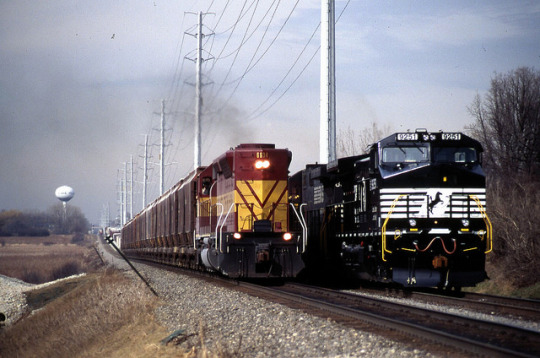
Hammerhead by The Mastadon on Flickr.
Caption: “Wisconsin Central SDP45 6634 had L201, the Rock Job for Grayslake, well in hand hammerhead-style as it lapped a dead southbound FDNS with a freshly caught Catfish at Monaville Road in Lake Villa.”
February 10, 1999
Photo by Don Kalkman
#wisconsin central#illinois#rr#railway#railroad#railways#railroads#freight train#train#trains#track#tracks#locomotive#diesel locomotive#WC#norfolk southern
37 notes
·
View notes
Text
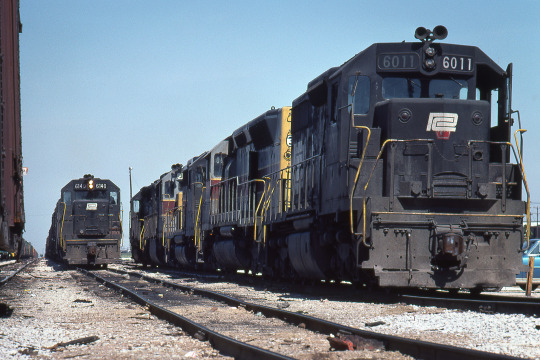
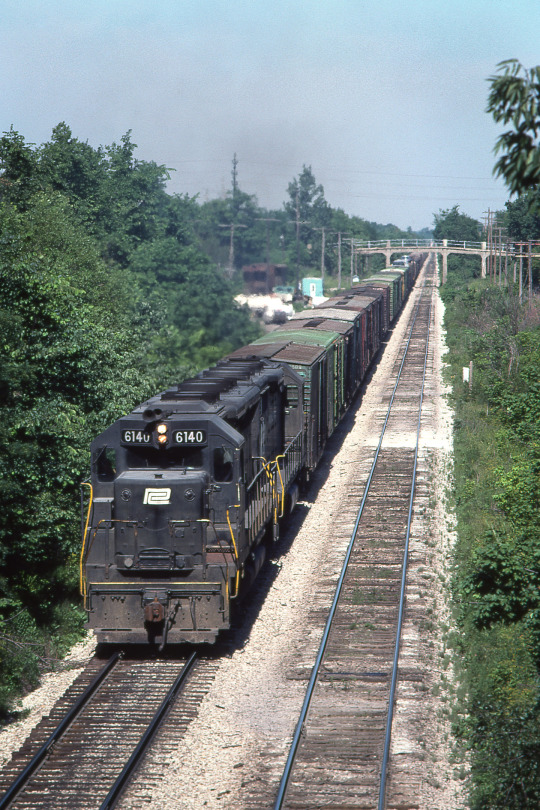
Westbound from Avon
The first image here shows a westbound train ready to depart Avon Yard (in the distance, on the left hand side of the frame). We're on the former Big Four/NYC west of Indianapolis.
Conrail is two months old when these pictures were taken so the power standing off to the side is interesting—three units of the Erie Lackawanna along with a Penn Central unit with a Pennsy logo peeking out. Two of three EL units (SD45-2 and SDP45) were purchased with the idea of having larger fuel capacity for long runs from the east to Chicago without refueling.
The second image has the train down the line about six miles, directly south of Danville, Indiana. We're looking down on the railway from State Road 39.
Two images by Richard Koenig; taken June 5, 1976.
#railroadhistory#railwayhistory#penncentral#conrail#erielackawanna#sdp45#sd45-2#danvilleindiana#avonindiana#avonyard#bigfour#newyorkcentral
65 notes
·
View notes
Video
Santa Fe #92 por SD80MAC_4103
Por Flickr:
My absolute favorite EMD product to ever roll out of La Grange was the FP45. Built at the request of Santa Fe for a passenger locomotive that "looked" like a passenger locomotive, but could also later be easily converted to freight service if needed, EMD to the SDP45 and added a streamlined cowl. Setting the standard for what would later become the North American Safety Cab (including the signature tear drop windshields), the result was a classic, utilitarian yet classy look, only made better by the ATSF's Warbonnet scheme. #92 has been a part of the collection at IRM since 1999. A few years ago, the engine went to NRE's Silvis shops where it was rebuilt and returned to operation. Unfortunately for me during Diesel Days 2013, the "Big Jack", as Santa Fe crews called them, was tucked away inside the shop during the festivities.
9 notes
·
View notes
Video
A Psuedo-3200 by Greg Brown
Via Flickr:
Late in the passenger game - 1967, to be exact - Southern Pacific acquired ten SDP45s to pull its dwindling fleet of intercity passenger trains. The ten EMDs (SP 3200-3209) eventually found their way to the San Francisco Peninsula commute operation, followed by freight service. All were retired and off the roster by 1990.
In 1994, SP began taking delivery of 133 locomotives remanufactured by Morrison-Knudsen to SD40-2 standards. Six of the units used in the program were SDP45s originally built for Erie Lackawanna. They immediately evoked memories of their departed passenger cousins.
Nearly two years after Union Pacific acquired SP, one of the MK rebuilds leads a baretable train at Mott, California. A crew change at Dunsmuir is around ten miles distant.
June 14, 1998
23 notes
·
View notes
Video
SP 3201 with 52 MTZ Apr 25 1971 Truckee Ltdx by Drew Jacksich
Via Flickr:
SP SDP45 #3201 with the San Joaquin Daylight at Martinez, The train on the right is the Truckee Limited, a PLA excursion which would be the last SP excursion train to operate before the coming of Amtrak.
April 25th, 1971
#san joaquin daylight#sp#southern pacific#1971#los angeles#oakland#trains#passenger train#history#martinez#california
22 notes
·
View notes
Photo
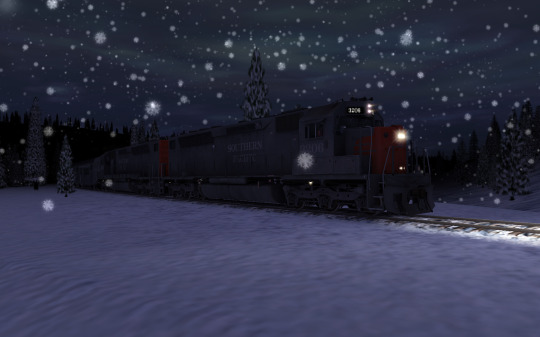
Day 23: EMD SDP45
Info from Wikipedia
The SDP45 is a six-axle, C-C, 3,600-horsepower (2,680 kW) diesel-electric locomotive built by General Motors' Electro-Motive Division of La Grange, Illinois. It was a passenger-hauling version of the SD45 on a stretched locomotive frame with an extended, squared-off long hood at the rear, aft of the radiators, giving space for a steam generator for passenger train heating. This steam generator placement followed the pattern set by the SDP35 and SDP40. The Southern Pacific Railroad ordered their ten on May 9, 1966 with the units being placed in service between May 24 and July 26, 1967, initially on the City of San Francisco between Oakland and Ogden, and eventually used system-wide. As built, each unit carried 2,500 US gallons (9,500 l; 2,100 imp gal) of fuel and 3,000 US gallons (11,000 l; 2,500 imp gal) of steam generator water in a partitioned underframe tank. The steam generator was a Vapor Model OK-4740. SP's units had Pyle National Gyralights on the leading end, came with Nathan P-3 horns, and cost $317,156 each (SP's straight SD45's from the same period cost $290,788 each). Ordered with 62:15 gearing with the overspeed set at 72 mph (116 km/h), the gearing was changed to 60:17 (overspeed at 83 mph or 134 km/h) during 1968–1969. All except 3201 and 3207 would eventually be re-geared back to 62:15 once they entered commuter service. After Amtrak took over long-distance routes in 1971, various units were leased to Amtrak for West Coast service (primarily on the Coast Starlight) until Amtrak purchased their SDP40F locomotives, while the rest were used in freight service and on Company specials. Beginning in 1973 the SDP45s were used for commuter service on the San Francisco Peninsula Commute, replacing the Fairbanks-Morse Train Masters. SP's commuter service was demanding work and the locomotives required electrical modification to meet those demands. A "Passenger Start" switch was installed inside the cab electrical cabinet; in the "COMM" position the units were held in Parallel, in the "FRT/PASS" position normal transition was made. They stayed on the commute route (often working in freight service on weekends) until 1985 when Caltrain equipment arrived, and they were placed into freight service until their retirement, initially working out of Roseville, then in local and hauler service in the Los Angeles Basin. All were retired between 1986 (3208) and 1990 (3204) and sold for scrap. The Great Northern Railway purchased eight SDP45s in 1967 to replace F-units on the Empire Builder. Normally paired back-to-back, they were also used singly leading F-units. These joined six smaller SDP40 locomotives ordered in 1966 for the Western Star. After the startup of Amtrak in 1971, Great Northern Railway successor Burlington Northern Railroad converted all fourteen SDP locomotives to freight service. The Erie Lackawanna Railroad ordered 14 SD45Ms in 1969 and 1970. Intended for freight service, these units had standard (angled) long hood ends, the extra space aft of the radiators had concrete ballast. Their longer frames permitted a larger fuel tank which gave the locomotives a greater range between fuel stops. One Burlington Northern Railroad SDP45 (photo of BN 6599, closeup of HT-BB truck) was retrofitted with an articulated four-axle truck by EMD in 1983-84, converting it to an A1A-B+B wheel arrangement. The middle traction motor in the lead truck was removed and placed in the rear truck. The rear truck, called the HT-BB, for High Traction B+B arrangement, was tested successfully but advances in traction motors obviated the need for four axle trucks. This testing was not related to the development of the HTCR three-axle radial truck first seen under EMD SD60s and SD60MACs, and made standard on the early SD70 series. Southern Pacific Railroad 8691-8696 were SD40M-3 rebuilds done by Morrison-Knudsen. They were ex-EL 3654, 3668, 3666, 3665, 3662 and 3659. It is this group that most surviving SDP45s belong to. Erie Lackawanna Railroad 3639, later Conrail 6670, was listed as being preserved at the Virginia Museum of Transportation, although the museum's collection list does not show it. In August 2018, Youngstown Steel Heritage announced their intention to purchase 3639 and move it to their museum, with the goal of restoring it to operating condition, and eventually back to its original number and paint scheme. In September 2018, the group announced that they had successfully purchased the locomotive.
Models and Route by: Jointed Rail, Trainz-Forge, Auran, and Download Station
2 notes
·
View notes
Video
Conrail EMD SDP45 6673 by Craig Garver
Via Flickr:
Conrail EMD SDP45 6673 at Chicago, Illinois, October 16, 1977. Photographer: J R Quinn. Scanned from a 2 1/4 x 4 1/4 negative owned by Digital Rail Artist.
0 notes
Video
More Burlington Northern and the Colorado Joint Line -- 4 Photos by Marty Bernard
Via Flickr:
Roger Puta took four shots* of an intermodal on the Joint Line near Larkspur, CO in January 1985. The power consist was Burlington Northern 7111, 7897, 5792, and 6593 (SD40-2, SD40-2, U30B, and SDP45). ________ * Actually I do not know how many shots he took of this train. He was using two cameras and the slide numbers are not in any obvious sequence. Let me restate, Roger took at least 4 shots. Maybe I'll find more.
8 notes
·
View notes
